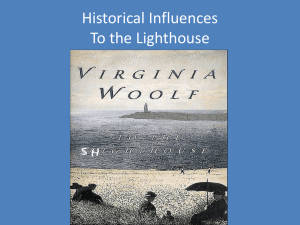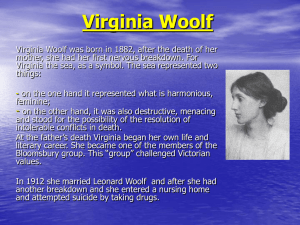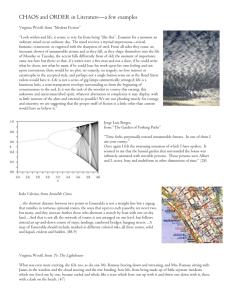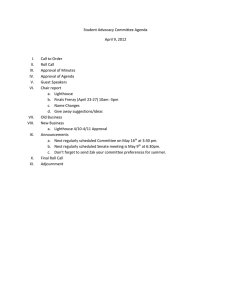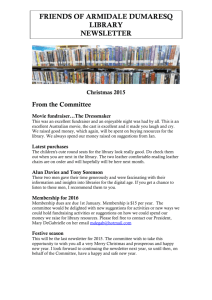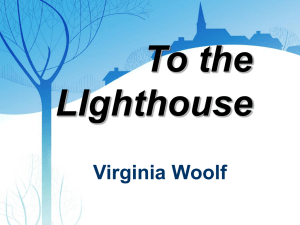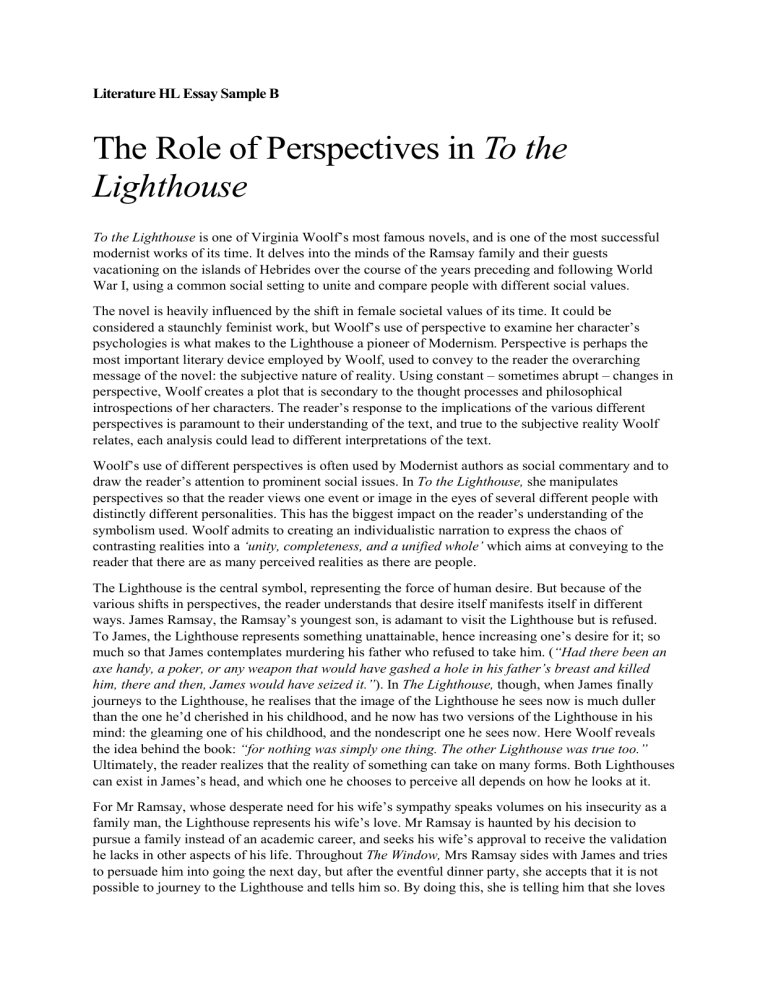
Literature HL Essay Sample B The Role of Perspectives in To the Lighthouse To the Lighthouse is one of Virginia Woolf’s most famous novels, and is one of the most successful modernist works of its time. It delves into the minds of the Ramsay family and their guests vacationing on the islands of Hebrides over the course of the years preceding and following World War I, using a common social setting to unite and compare people with different social values. The novel is heavily influenced by the shift in female societal values of its time. It could be considered a staunchly feminist work, but Woolf’s use of perspective to examine her character’s psychologies is what makes to the Lighthouse a pioneer of Modernism. Perspective is perhaps the most important literary device employed by Woolf, used to convey to the reader the overarching message of the novel: the subjective nature of reality. Using constant – sometimes abrupt – changes in perspective, Woolf creates a plot that is secondary to the thought processes and philosophical introspections of her characters. The reader’s response to the implications of the various different perspectives is paramount to their understanding of the text, and true to the subjective reality Woolf relates, each analysis could lead to different interpretations of the text. Woolf’s use of different perspectives is often used by Modernist authors as social commentary and to draw the reader’s attention to prominent social issues. In To the Lighthouse, she manipulates perspectives so that the reader views one event or image in the eyes of several different people with distinctly different personalities. This has the biggest impact on the reader’s understanding of the symbolism used. Woolf admits to creating an individualistic narration to express the chaos of contrasting realities into a ‘unity, completeness, and a unified whole’ which aims at conveying to the reader that there are as many perceived realities as there are people. The Lighthouse is the central symbol, representing the force of human desire. But because of the various shifts in perspectives, the reader understands that desire itself manifests itself in different ways. James Ramsay, the Ramsay’s youngest son, is adamant to visit the Lighthouse but is refused. To James, the Lighthouse represents something unattainable, hence increasing one’s desire for it; so much so that James contemplates murdering his father who refused to take him. (“Had there been an axe handy, a poker, or any weapon that would have gashed a hole in his father’s breast and killed him, there and then, James would have seized it.”). In The Lighthouse, though, when James finally journeys to the Lighthouse, he realises that the image of the Lighthouse he sees now is much duller than the one he’d cherished in his childhood, and he now has two versions of the Lighthouse in his mind: the gleaming one of his childhood, and the nondescript one he sees now. Here Woolf reveals the idea behind the book: “for nothing was simply one thing. The other Lighthouse was true too.” Ultimately, the reader realizes that the reality of something can take on many forms. Both Lighthouses can exist in James’s head, and which one he chooses to perceive all depends on how he looks at it. For Mr Ramsay, whose desperate need for his wife’s sympathy speaks volumes on his insecurity as a family man, the Lighthouse represents his wife’s love. Mr Ramsay is haunted by his decision to pursue a family instead of an academic career, and seeks his wife’s approval to receive the validation he lacks in other aspects of his life. Throughout The Window, Mrs Ramsay sides with James and tries to persuade him into going the next day, but after the eventful dinner party, she accepts that it is not possible to journey to the Lighthouse and tells him so. By doing this, she is telling him that she loves him. (“For she had triumphed again. She had not said it; yet he knew.”) For Mr Ramsay, this is an assurance that his wife accepts and trusts his intellect, which he has come to doubt recently. Here, the Lighthouse takes on another meaning: the abandonment of a desire Mr Ramsay deems irrational in favour of trusting one’s partner’s judgement, which he considers far more valuable. By presenting these two different perceptions of a single symbol, Woolf not only enhances the value of the Lighthouse as a symbol, but also draws the reader’s attention to tense relationship between James and his father, a callout to the Freudian psychology which was popular at the time, and an large influence on Woolf’s work. Later, at the end of the book, their relationship is repaired after they reach the shores of the Lighthouse when James accepts how different the Lighthouse looks, and Mr Ramsay finally yields willingly to his family’s needs, taking James and Cam to the Lighthouse. This could be interpreted as Woolf telling her readers that good relationships depend on both parties realizing that there is more to a person than just their perception of them, and accepting all their realities. In a more authorial view, the most important symbol would be Lily Biscoe’s painting, something she constantly agonises over and refuses to let anyone view. The painting represents her understanding of Mrs Ramsay, which she cannot seem to complete because of how different their values are. Her singular perspective of this painting, uninterrupted by any other opinions is symbolic of Woolf’s own internal struggles to capture her own reality and understanding through the writing of To the Lighthouse. When Lily accepts that she “would need fifty pairs of eyes” to truly understand Mrs Ramsay in the conclusion of the novel, it is Woolf herself surrendering to the fact that there are too many different realities preventing her understanding of the old domestic order Mrs Ramsay adheres to, concluding the book as Lily completes her painting. Another large role of perspectives in To the Lighthouse is its effect on time. Modernist authors often use time to structure their plot in a non-linear form, giving it a more psychological basis than an action based one. The manipulation of time allows authors to show that the passage of time depends on the perceived significance of the situation the characters find themselves in. Perspectives and the perception of the time work in tandem to better show the reader the individualistic reality Woolf conveys. The Window, the first section, is the longest part of the novel, narrating the events of one day, whereas the ten years in between their first visit to the guest home and their second, which is covered in Time Passes, is barely fifteen pages long. Events a reader would consider important, like Mrs Ramsay’s, Prue Ramsay’s and Andrew Ramsay’s death, which happen during their decade long absence, are mentioned in mere. The narration in Time Passes takes a more objective turn, relating events in the barest way possible, making the narration of this section chronological. Because of the lack of opinion and perspective, Woolf is able to compress ten years into ten pages. But that’s not the only reason perspective is absent – the lack of perspective implies that only death is objective and final. Death is the only certainty in human life, whereas any other aspect can be entirely subjective in nature. The reader realises that the impacts of Mrs Ramsay’s death are given more importance than her death itself, with Lily Briscoe’s narrative taking over most of The Lighthouse, and her revelation ending it. But what would have taken a minute to happen is explained over several pages, with the narrative style reverting back to the psychological one used in The Window. Even though a revelation is of less importance and time than a death of a loved one, its significance to Lily and her appreciation of the world gives it more magnitude than Mrs Ramsay’s death. The book ends on a blue skied morning when Mr Ramsay takes James to the Lighthouse, almost as if continuing where The Window left off after the dinner party and ending with James visiting the Lighthouse as he had always wanted to. The cyclical nature ties in with Woolf desire to create a complete novel that captures the chaos of life into something unified. Virginia Woolf’s ability to turn a simple island vacation into a psychological insight into the motives and desires of the Ramsay family is what made To the Lighthouse one of the most critically acclaimed books of the twentieth century. It’s divergence from Victorian plotlines with the adoption of techniques characteristic to Modernism, especially perspective, individualism, and symbolism pioneered a literary revolution in which human experience was given more influence over the course of the plot. Such narration offers Woolf a chance to direct the reader’s attention to certain social situations, hence using the novel as a medium of social commentary too, apt for the changing social and political climate Woolf wrote in. Many techniques inspired from Woolf’s works are still used today, To the Lighthouse still remains one of the most thought provoking novels of all time. Word Count – 1497 words Sources: 1. Woolf, Virginia. To the Lighthouse 2. Aboudaif, S. A. (2020). Conceptual Symbolic Narration in Virginia Woolf’s To the Lighthouse and the Waves from a Reader-response perspective.
